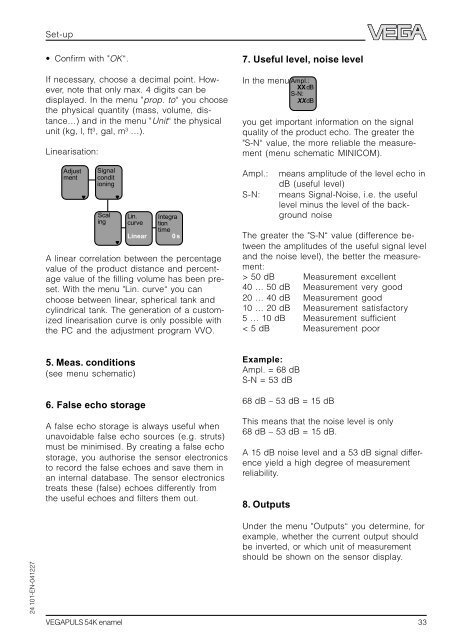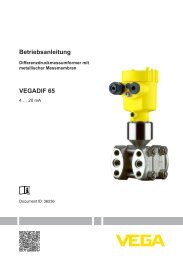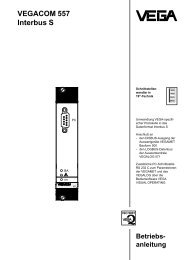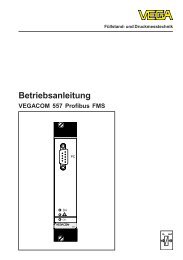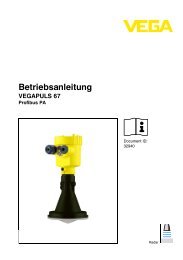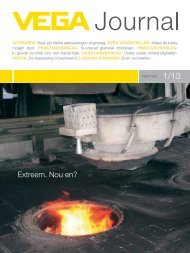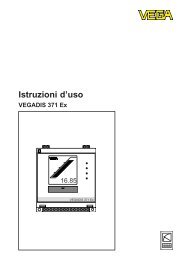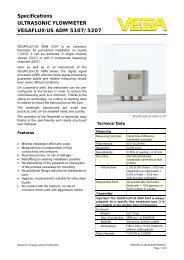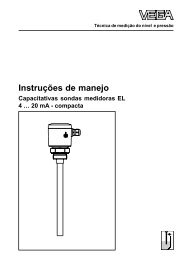Operating Instructions - VEGAPULS 54K enamel
Operating Instructions - VEGAPULS 54K enamel
Operating Instructions - VEGAPULS 54K enamel
You also want an ePaper? Increase the reach of your titles
YUMPU automatically turns print PDFs into web optimized ePapers that Google loves.
24 101-EN-041227<br />
Set-up<br />
Confirm with "OK“.<br />
If necessary, choose a decimal point. However,<br />
note that only max. 4 digits can be<br />
displayed. In the menu "prop. to“ you choose<br />
the physical quantity (mass, volume, distance…)<br />
and in the menu "Unit“ the physical<br />
unit (kg, l, ft 3 , gal, m 3 …).<br />
Linearisation:<br />
Adjust<br />
ment<br />
Signal<br />
condit<br />
ioning<br />
Scal<br />
ing<br />
Lin.<br />
curve<br />
Linear<br />
Integra<br />
tion<br />
time 0 s<br />
A linear correlation between the percentage<br />
value of the product distance and percentage<br />
value of the filling volume has been preset.<br />
With the menu "Lin. curve“ you can<br />
choose between linear, spherical tank and<br />
cylindrical tank. The generation of a customized<br />
linearisation curve is only possible with<br />
the PC and the adjustment program VVO.<br />
5. Meas. conditions<br />
(see menu schematic)<br />
6. False echo storage<br />
A false echo storage is always useful when<br />
unavoidable false echo sources (e.g. struts)<br />
must be minimised. By creating a false echo<br />
storage, you authorise the sensor electronics<br />
to record the false echoes and save them in<br />
an internal database. The sensor electronics<br />
treats these (false) echoes differently from<br />
the useful echoes and filters them out.<br />
7. Useful level, noise level<br />
In the menu Ampl.:<br />
XX dB<br />
S-N:<br />
XX dB<br />
you get important information on the signal<br />
quality of the product echo. The greater the<br />
"S-N“ value, the more reliable the measurement<br />
(menu schematic MINICOM).<br />
Ampl.: means amplitude of the level echo in<br />
dB (useful level)<br />
S-N: means Signal-Noise, i.e. the useful<br />
level minus the level of the background<br />
noise<br />
The greater the "S-N“ value (difference between<br />
the amplitudes of the useful signal level<br />
and the noise level), the better the measurement:<br />
> 50 dB Measurement excellent<br />
40 … 50 dB Measurement very good<br />
20 … 40 dB Measurement good<br />
10 … 20 dB Measurement satisfactory<br />
5 … 10 dB Measurement sufficient<br />
< 5 dB Measurement poor<br />
Example:<br />
Ampl. = 68 dB<br />
S-N = 53 dB<br />
68 dB – 53 dB = 15 dB<br />
This means that the noise level is only<br />
68 dB – 53 dB = 15 dB.<br />
A 15 dB noise level and a 53 dB signal difference<br />
yield a high degree of measurement<br />
reliability.<br />
8. Outputs<br />
Under the menu "Outputs“ you determine, for<br />
example, whether the current output should<br />
be inverted, or which unit of measurement<br />
should be shown on the sensor display.<br />
<strong>VEGAPULS</strong> <strong>54K</strong> <strong>enamel</strong> 33


